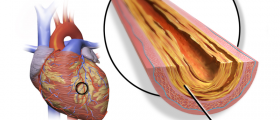
Excess amounts of cholesterol or triglycerides in the blood is medically called hyperlipidemia. Some doctors may also refer to this problem as hyperlipoproteinemia, since these both cholesterol and triglycerides need proteins and flow through the blood associated with them.Therefore, there are two distinctive types of hyperlipidemia, depending on the type of fatty substance that has been elevated. There is hypercholesterolemia (heightened level of cholesterol) and then there is hypertriglyceridemia (high level of triglycerides in the blood)
What Causes Hyperlipidemia?
Hypertriglyceridemia is commonly caused by diabetes and certain prescription drugs, such as estrogen (in hormone replacement therapy, HRT) or corticosteroids. Obesity and excess intake of alcohol may also be the reasons behind this medical condition.
Hypercholesterolemia, on the other hand is commonly described as elevated level of one specific substance known as LDL (low density lipoproteins) and can be caused by pregnancy, low level of thyroid hormones or kidney failure.
Hyperlipidemia Symptoms and Risks
Most patients suffering from any of two types of hyperlipidemia have no visible symptoms or problems related to this problem. This condition is commonly diagnosed after routine examination or patient’s evaluation for atherosclerotic cardiovascular disease. Some of the patients with hypertriglyceridemia may experience skin lesion all over the body, or pancreatitis, if the level of triglycerides seems to be extremely high. Inflammation of the pancreas is (pancreatitis) very serious medical problem, which may end up fatally if left unattended.
Hypercholesterolemia patients could develop cholesterol deposits under the skin, better known as xanthomas. These structures are usually found around the eyes or along Achilles tendon and frequently seen in patients with very high level of blood cholesterol.
Patients who smoke, have diabetes of high blood pressure, as well as positive family history and hyperlipidemia diagnosis are considered to be exposed to greater risk of development of coronary heart disease.Prevention and Treatment Options
Lifestyle changes are common advises for all high risk hyperlipidemia patients, including smoking cessation, maintaining of healthy body weight, regular physical activity and healthy diet. These people should eat food low in saturated fats and limit their alcohol consumption. Diet alone may be able to lower blood cholesterol for some 15% but only in strictly controlled surrounding such as hospital.
Treatment is commonly consisted of dietary and lifestyle changes, as well as reduction of excess weight and physical activity. LDL cholesterol should be kept under 100, 130 or 160mg/dl, depending on the risk factors for development of diabetes and heart diseases, while triglycerides must be under 200mg/dl of blood. At the same time, doctors advise that optimal “good” cholesterol HDL (high density lipoproteins) should be over 40mg/dl.
Commonly used medications include statins (atorvastatin, simvastatin), ezetimibe, sequestrants, nicotinic acid and fibrates, such as gemfibrozil and fenofibrate.

















Your thoughts on this
Loading...